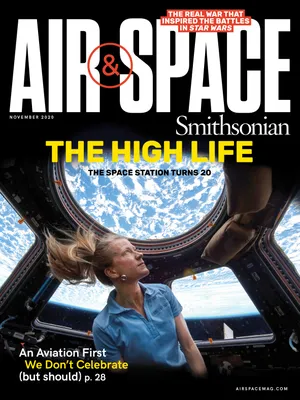The ISS Has Made Us a Space-Dwelling Species
Celebrating 20 years of continuous human presence in orbit.
:focal(2810x1802:2811x1803)/https://tf-cmsv2-smithsonianmag-media.s3.amazonaws.com/filer/2d/d9/2dd9e12c-b133-4b97-acec-1f1b6d5b33f3/25a_on2020_2020iss_48826753686_a91637f950_live.jpg)
October 31, 2000 was the last time in all of human history that every person could look up and out above our atmosphere knowing we were all within its protective biosphere. But since Bill Shepherd, Yuri Gidzenko, and Sergei Krikalev departed Baikonur Kosmodrome that day, there has always been someone in space—keeping watch over our home on Earth and an eye on our hopeful future among the stars. The crew reached the International Space Station two days later as the first inhabitants of that amazing laboratory, observatory, and symbol of what can be achieved through international cooperation.
It took a bit more than the 10 years President Ronald Reagan called for in his 1984 State of the Union address to manufacture on the ground and assemble in space the initial core of the ISS. U.S. space shuttles and Russian rockets ferried the components built by 15 partner nations, and have continued adding to and updating the station ever since.
The goal, Reagan said, was “living and working in space for peaceful economic and scientific gain.” On that score, the ISS has delivered incredibly well. From medicine and materials research to understanding how plants and animals react to microgravity, the ISS has provided the ability to do things possible only on a long-duration, stable orbital lab.
The station has also helped us understand how to endure extended time in space. (See the story on p. 40.) That will be key for our next leaps into the solar system. We have also learned about building and repairing spacecraft off-Earth, a vital lesson for any Mars-bound crew.
I believe the two decades of ISS habitation should lead to an unbroken chain of space dwelling for the rest of humanity’s time in the universe. That will, however, take commitment. Being a true space species will require technological advance (for space habitability and sustainability), international cooperation (to get new stations launched and occupied before the ISS becomes unusable), and good fortune (with only one outpost in orbit, we are one bad day away from becoming grounded).
If nothing else, though, the ISS should make us optimistic. Every day, people around the globe look up to see the ISS pass overhead knowing others are up there going through a familiar day’s routine and realizing we do have a permanent home in the heavens—if we can keep it.
